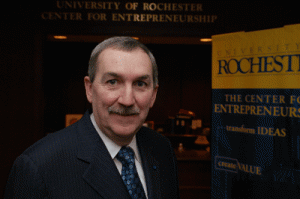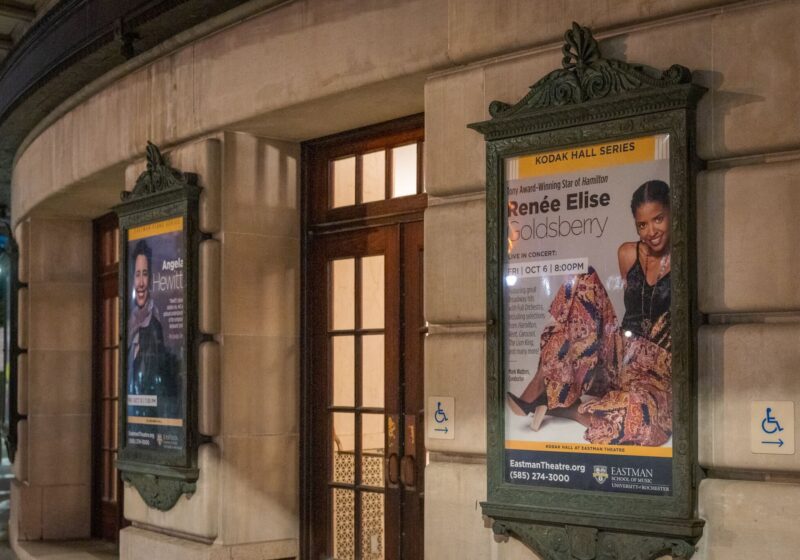
Courtesy of rochester.edu
Three weeks ago, Eastman Kodak Company, the 131-year-old forerunner of the camera industry, filed for Chapter 11 bankruptcy protection. It was news that saddened the UR community and the city of Rochester as a whole.
According to engineering professor and Vice Provost of Entrepreneurship Duncan Moore, the demise of this icon does not mean the end of Rochester.
In a New York Times op-ed published on Thursday, Feb. 2, Moore expressed optimism about the future of the city. “While no one here is glad to see Kodak go bankrupt, it’s hardly the catastrophe many imagined,” he wrote.
The company had made a majority of its layoffs prior to its declaration of bankruptcy. At its prime, Kodak employed 61,000 workers. In 2009, 4,900 workers were laid off. Recently, the number of employees was down to less than 7,000.
Moore sees the downsizing as a blessing in disguise.
“The high-skilled workers [Kodak] let go over the years created a valuable labor pool for start-up companies, particularly in optics and photonics,” he said.
These start-up companies were helped by Kodak’s weakening. Two decades ago, Rochester began to offer valuable resources to budding entrepreneurs through organizations such as High Tech Rochester and Greater Rochester Enterprise. These organizations prepare and support new business-people in their ventures, many of which are directly tied to UR.
Indeed, UR has played a vital role in keeping the city afloat. With 19,000 faculty and staff members between the various campuses and the medical center, it is the largest employer in the area. In 2011, UR was ranked as one of the top 40 workplaces for scientists in academia by The Scientist Magazine.
UR has received billions of dollars in research money in the past five years which has “fueled local growth beyond the campus gates,” Moore wrote.
Perhaps most importantly, UR provides a student population of thousands of potential future contributors to the welfare of the city. In Moore’s opinion, taking advantage of the “local intellectual capital” is key.
“Public and private organizations should build connections with students through internships and other efforts that give graduates a reason to stick around,” Moore said.
Is the city effectively using its “intellectual capital”? Does the city of Rochester give graduates “a reason to stick around”?
Senior Joe Ciminelli believes that it does.
“The City of Rochester knows that the intellectual capital in this area is a great and wonderful resource,” he said. “I definitely feel that they take advantage of such capital and use it to make the entire Rochester community ever better.”
Senior Aaron Eisenberg, however, sees Rochester’s opportunities for students as merely adequate.
“[The city] does experience a bit of a brain drain with students coming here for the University and then leaving, but that is to be expected of any mid-sized city that doesn’t have the allure of the major cities,” he said.
Alumnus Dana Hilfinger ’10 also acknowledges the “brain drain” as an issue in Rochester. However, she thinks it is a mistake to place the blame on the city.
“From my own experience, people at UR have always seemed to frame the whole brain drain, lost intellectual capital issue as if it were only the city of Rochester’s problem,” she said. “I actually tend to think of it more as UR’s problem and as a reflection of their lack of effort in getting students out into the community.”
She believes that the University needs to do its part to increase student involvement in the city, perhaps through a community service requirement. Hilfinger thinks that students who venture off campus have an abundance of reasons to stay.
“[Rochester] has so much beauty — the parks, the people and the spirit — and is so unique that sometimes it’s tough for me to understand why more students don’t consider it a good place to live,” she explained.
Alumnus Conor Willis ’11 agreed. “My gut feeling after living in the city, and not just on the UR campus, is that Rochester is a very close-knit community, which is another bonus,” he said. “I’m pretty upbeat on this community, I see a lot of people doing a lot of good things.”
Hansler is a member of the class of 2015.


